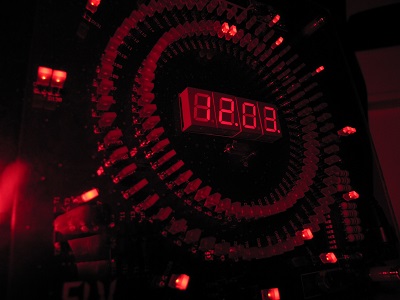Time is “what we read from a clock located at the same point at which an event occurs”, said Albert Einstein. American theoretical physicist John A. Wheeler defined it as “a phenomenon which prevents all things from happening simultaneously.”
While time remains an eternal mystery for philosophers and scientists, the language of art tries to represent it. German artist Kerstin Ergenzinger, fellow of the graduate school at the Berlin Center for Advanced Studies in Arts and Sciences, started cooperation with a team of physicists who are trying to create a highly precise clock using the nucleus of the Thorium-229 atom.
“The atomic clocks that we know today rely on an oscillator that produces an electromagnetic wave, and the atomic reference is used to control the frequency of this wave, in order to guarantee the precision of the clock,” explains Ekkehard Peik, head of the “Time and frequency” department at the German National Metrology Institute in Braunschweig, partner of the of the European nuClock project. “By using Thorium 229 we propose an oscillation inside the atomic nucleus, where the charges are much more tightly bound and where the forces are stronger, thus making the frequency measurement more robust against external perturbations.”

While time measurement means many calculations and laboratory experiments for the scientists, Kerstin Ergenzinger wants to express the cadence of time through sounds.
She is building an acoustic instrument, based on nitinol drums, able to filter equally distributed random noises. The drums are arranged in a cloud-like formation and suspended from a ceiling, which creates a sonic environment evolving in time and space.
Nitinol is a super-elastic memory alloy of nickel and titanium that exhibits robotic and acoustic effects. Each drum consists of a tube of variable length and material and has its own characteristics, resonance and frequencies.
Visitors can explore regions in time and space, roaming freely and listening. What appears to be noise turns into a meaningful signal, a frequency representing the cadence of time. “People are challenged to define this signal. Eventually, this study will also be an experiment and exercise in awareness and fine-tuning,” says Ergenzinger.
It is the point where science and art connect, even without a direct link. “I’ve noticed that many scientists are interested in art, and also vice versa, and that scientific models of the structure of matter and of the universe have inspired artists,” Peik points out.
The nuClock researchers seek to detect an elusive nuclear state in the Thorium 229 isotope, whose frequency is very faint and masked by strong “noises”. This state forms the basis of a future nuclear clock, able to reach a much higher precision compared to the best clocks operated nowadays.
Thorium 229 is a radioactive isotope and artificially produced in a nuclear reactor. However, it is not a major concern for the scientists, because they use only few micrograms for this experiment. The atom’s unique features, such as its low sensitivity to external perturbations, led the scientists to take the challenge. Time precision is very important in sectors like satellite navigation, telecommunication, data transfer and computer synchronisation.
The scientific experiments are still in a relatively early phase, and are backed by the European Union within the FET-Open initiative. As for the instruments trying to reproduce the sound of time, Ergenzinger is still studying the filtering of numerous different noises. The final version is due to go public in 2018. The collaboration between the artist and scientists has been inspired by the FEAT project (Future Emerging Art and Technology).
In the picture above: Atomic clocks are the backbone of today‘s satellite-based global navigation and telecommunication. The nuClock consortium is working on the next generation: the nuclear clock using Thorium-229. Copyright: T. Schumm, Vienna Technical University
youris.com provides its content to all media free of charge. We would appreciate if you could acknowledge youris.com as the source of the content.